How to Grow Brussels Sprouts for Beginners
Get the steps from seed to table on How to Grow Brussels Sprouts for Beginners. Try something new in your backyard garden and really fill your pantry, freezer, and stomach with some amazing organic food! How to grow vegetables you and your family will love to eat.
Successful gardening 101 is all about growing and this guide will get you off to a great start!
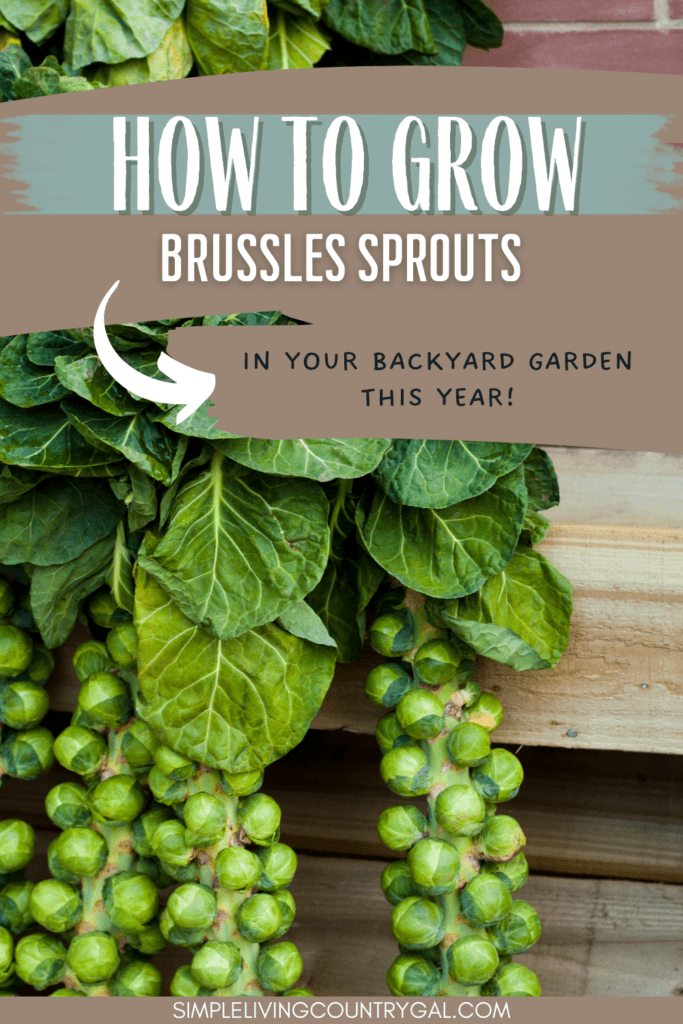
Even though Brussels sprouts date back to ancient Rome, they’re named for the city of Brussels in Belgium where they’ve been enjoyed for centuries. Brussels sprouts are part of the cabbage family and even look like mini heads of cabbage.
Brussels sprouts are both delicious and nutritious; a great addition to a beginner garden. They’re a cool weather, slow-growing biennials crop and they grow best in cooler regions or in early spring or fall in other regions. They even appreciate a frost or two, hot temperatures will make them flimsy and bitter.
They form on thick stems that have broad leaves. The leaves can also be enjoyed, both raw and cooked, like many other hardy greens.
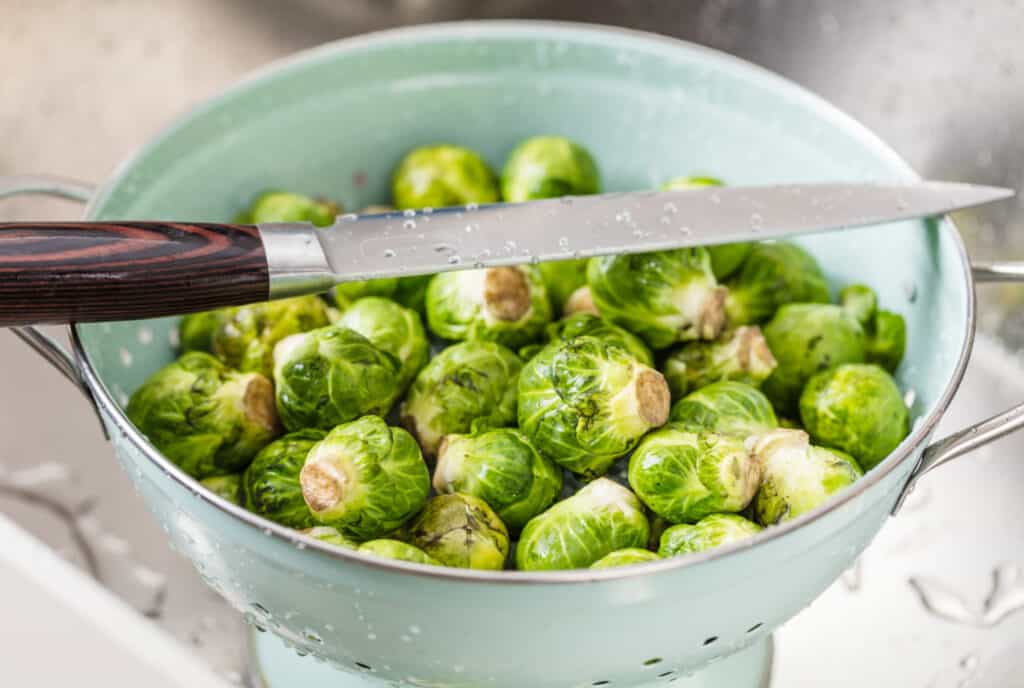
There are a few varieties of brussels sprouts to choose from; be sure to select a variety that will grow well in your local growing conditions.
· Long Island Improved – produces tightly packed plants that are about 1 inch in size.
· Rubine – this variety can take up to 105 days to mature and have a red hue. They grow best in northern climates.
· Jade Cross – this variety is best for southern gardeners because they are more tolerant of heat.
· Oliver – this fast-maturing variety will be ready to harvest in about 85 from transplanting, a little longer when growing from seeds.
· Diablo, Royal Marvel, and Tasty Nugget – these varieties are also suitable to southern regions as they can tolerate some heat and mature quickly from transplants.
Seed, Bulb, or Plant?
There are two ways to plant Brussels sprouts, seeds or transplants. Both ways will grow a full harvest. Seeds are less expensive and require a longer growing period for the seeds to germinate while transplants will be ready to harvest faster.
What You Need to Grow Brussels Sprouts
Brussels sprouts require a longer growing season than many other garden vegetables and prefer cooler temperatures, even a frost or two. Plan to plant them before the last frost, in early spring, or in late summer before the first frost of fall. If you live in a southern region where you experience higher temperatures, consider planting transplants instead of seeds in order to harvest before the temperatures rise.
When to Plant Brussels Sprouts
Brussels sprouts require a long growing season, usually 80 to 105 days depending on the variety, and the flavor improves if they’re subjected to a light frost. With this in mind, plan on planting seeds approximately four months before the first frost of fall in areas with colder winters, meaning early to mid-summer depending on. This will give you a fall to early winter harvest. For areas with milder winters, you can typically plant in the mid- to late summer for a mid- to late winter harvest.
Temperature
Temperatures as low as 45° F and not higher than 80° F are usually perfect for Brussels sprouts, although they can tolerate short spells of below freezing temperatures. Humidity is usually not an issue as long as the soil stays moist and the air flow around the plants is good.
Sun
Full sun of at least 6 hours a day of direct sunlight on most days is best for Brussels sprouts. Too much shade will slow the growth season and it will take longer for them to mature.
Soil
Loamy, well-draining soil rich in organic matter is ideal for Brussels sprouts. Ideally, you should mix a thick layer of compost into the soil before planting. Keep the soil pH neutral, 6 to 7.
If your soil is not in good quality, you will want to improve your soil first.
Water
The soil should be moist but not soggy, make sure the water can easily drain so it doesn’t pool around the roots. Water about 1 to 1 1/2 inches per week. Inconsistent watering will result in poor development of the sprouts. A layer of mulch on top of the soil will help it retain moisture and keep the roots cool.
Fertilizing
Once the seedlings reach about 6 inches tall, add an organic vegetable fertilizer that’s high in nitrogen and reapply it throughout the growing season.
Support
Brussels sprouts don’t require a large support but they may require support stakes to keep the stems from toppling over. It can be more helpful to place support stakes at the time of planting.
How Much to Plant
Usually, 2-5 plants per person is plenty when it comes to Brussels sprouts. Each plant will produce as many as 50 sprouts.
Before breaking ground, know how big of a garden you need to feed your family.
How Long Do Brussels Sprouts Take to Grow?
Depending on the variety, you can expect the plants to take 80 to 105 days to be ready to harvest from seeds, a little less when planting transplants.
How to Plant Brussels Sprouts
Select a spot that gets plenty of sun and has good drainage. If you live in a warmer climate, you may want to consider a raised bed or containers because they can withstand temperature fluctuations better.
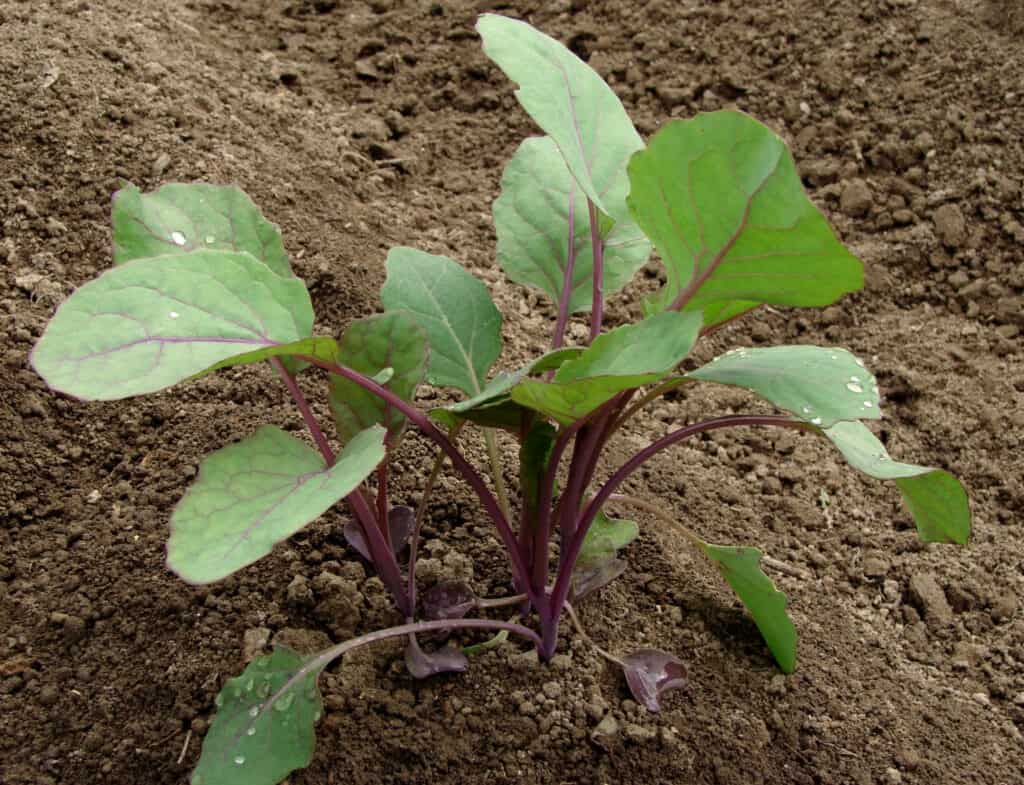
Keep Brussels sprouts away from strawberry plants and anything in the nightshade family, like tomatoes, as they can inhibit the growth of the sprouts.
Add organic matter or compost to your soil before planting to provide plenty of nutrients.
Planting Seeds
Seeds can be started indoors and transplanted or planted directly in the ground depending on how many growing days of temperatures between 45° F and 80° F you have ahead. There can be a problem with starting them indoors though. You’ll need to start them early enough that there are still enough cool days to allow them to mature outside but not so early that the plants grow leggy and weak from spending too much time indoors.
For spring planting you’ll want to get the seedlings planted outside as early as possible. Seeds can be sown directly into the ground about 4 to 6 weeks before the last frost, at the latest.
Plant the seeds about a half inch deep and about 3 inches apart. Once they start to germinate, you can thin the plants to 18 to 24 inches apart to allow them plenty of room for the sprouts to mature.
Once planted, water the soil well.
Planting Seedlings or Transplants
Prepare the bed by working some compost into the soil. This will provide nutrients for the plants and also improve the drainage of the soil.
Dig holes that are slightly larger than the pots you’re planting and space them about 18 to 24 inches apart. Seedlings will need to be planted up to the base of the stem so dig the holes appropriately. If using compostable pots, you will not need to remove them from the pots; plant the seedlings and pots as one.
Place the seedlings (and pots if they’re compostable) in the holes, they should be the same size as the container, and fill around with soil. Finish by watering to allow the plant and soil to settle.
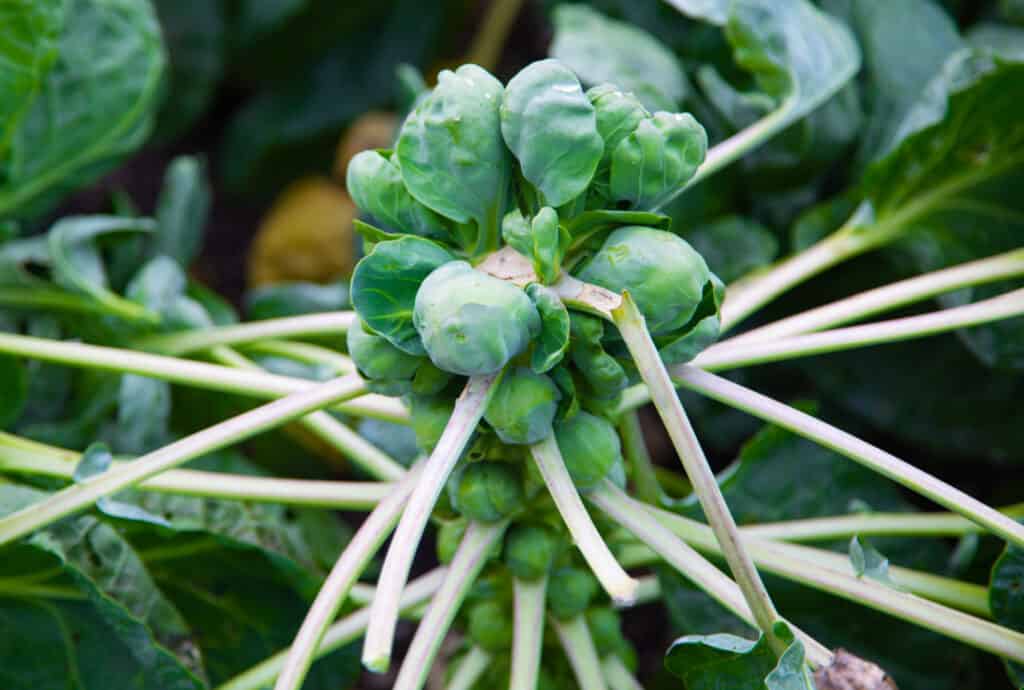
Spacing
Give plants plenty of room to develop sprouts by planting seeds at least 3 inches apart. Once they start to grow, thin out the seedlings to 18 to 24 inches apart once they are about 6 inches tall.
Depth
Seeds should be planted about a half inch deep. For transplants, plant up to the base of the stem.
Growing Tips for Brussels Sprouts
· Adding a layer of mulch over the soil can help it retain moisture, suppress weeds, and keep the roots cool.
· Adding support stakes at the time of planting can help support the stems as they start to grow and become heavy with sprouts.
· Planting transplants will shorten the growing season, making them ideal for warmer climates. Planting seeds are fine in cooler climates when there is a longer growing season available.
· If planting in the spring, earlier is better so that the plant has enough time to develop before the temperatures rise too high.
· A light frost or two will improve the flavor of the sprouts so try to plant before the last frost of spring or the first frost of fall.
· Keep soil moist but not soaked. Brussels sprouts enjoy a lot of water but you don’t want to drown the roots.
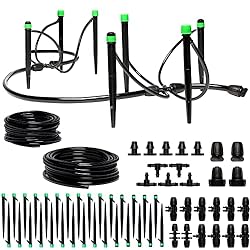
· Brussels sprouts have a shallow root system so be careful with a hoe or trowel that you don’t damage them.
· Planting mustard nearby as a trap crop will help reduce pests as the pests are more attracted to the mustard.
· Planting with nasturtiums and marigolds will help to attract beneficial insects like ladybugs that can help to deal with some of the problem bugs.
· A little pruning can help to maximize your harvest. Remove the top of the plant which will encourage larger heads. This can be done 30 to 60 days before harvest.
· Avoid removing lower leaves unless there is a reason to such as pests or diseases.
How to Harvest Brussels Sprouts
Sprouts mature from the bottom of the stalk first and continue upwards so harvest from the bottom of the plant first when heads reach about 1 inch in diameter. If you’d like, you can pull the entire stalk, roots and all, after a moderate frost.
Remove the leaves and hang the stalks upside down in a cool dry basement, barn, or garage. The stalks, without roots, can be stored for about a month.
How to Store Brussels Sprouts
Don’t wash the sprouts before storing this, it can cause them to rot. Wait to wash until you’re ready to use. Gently pluck the sprouts that you want from the stalk. Keep fresh picked sprouts in the refrigerator in a plastic bag for up to 5 days.
Diseases and Pests to Watch Out For
Like other fruits and vegetables in your garden, Brussels Sprouts are susceptible to some pests and diseases. A few to watch out for include:
· Aphids – they’ll cause yellow, misshapen leaves and leave a sticky excrement. Companion planting can help or simply knock them off the leaves with a water spray.
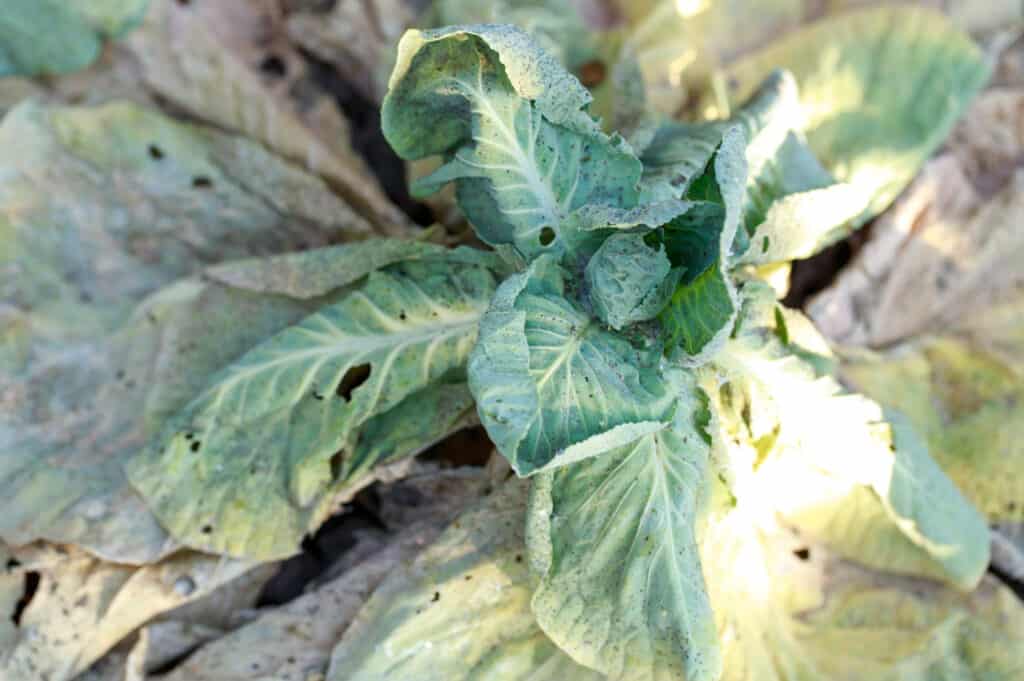
· Black Rot – this fungus will turn the leaves yellow. Try to choose resistant variants and provide good drainage. Destroy any infected plants.
· Cabbage Loopers, Cabbageworms, and Cabbage Root Maggots – they’ll leave large holes in the leaves and cause wilted or stunted plants. Handpick them off and use row covers to prevent them.
· Clubroot – this will cause wilted plants and yellow leaves. Destroy any infected plants and check the pH level of the soil.
· Downey Mildew – yellow spots on upper leaves and white, purple, or gray cottony growth on the undersides of the leaves. Choose resistant varieties, make sure there is good air circulation, and avoid overhead watering to keep the problem away.
· Flea Beetles – numerous tiny holes will appear in the leaves. Use row covers to prevent and mulch heavily. Companion planting can invite beneficial insects that will keep these away.
· Stinkbugs – yellowy white blotches will appear on the leaves causing scarring, dimpling, or distortion. Destroy any crop residue and handpick the bugs off leaves wearing gloves, they emit an odor, use row covers to prevent and till the soil after harvesting.
· White Mold – pale gray areas will appear on stems, leaves, and other areas of the plant. Destroy any infected plants and make sure there is good air circulation. Water in the morning, weed, and destroy any crop residue.
Brussels sprouts are a healthy, nutritious addition to any garden and they’re fairly easy to grow, making them a good crop for beginner gardeners.
If you plan your planting around temperatures and frosts, you can easily grow two crops a year in both the spring and fall, allowing you to enjoy fresh Brussels sprouts often.
